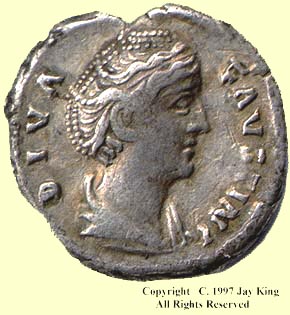 Contents -
Previous Article -
Next Article
Contents -
Previous Article -
Next Article
Not much is known about the lives of the emperors and empresses of the Second Century. Our best primary sources, Tacitus and Suetonius are dead. The Historia Augusta is not known for its accuracy, being a collection of gossip and fanciful tales. Pliny the Younger sheds some light on this period, and Dio Cassius does not appear until the reign of Commodus. What we know about the two Faustinas, Elder and Younger, must be pieced together from monumental inscriptions, legends on coins, and the few cases in which writers actually describe events of their lives.
Faustina the Elder was loved very much by her husband, the emperor Antoninus Pius. They lived happily together during one of the most peaceful and prosperous periods of Roman history. The empire had reached its greatest extent under Trajan in the early Second Century but Hadrian found it more expedient to give up all territory across the Danube for the sake of a strong, defensible frontier. During the next sixty years the empire enjoyed the economic prosperity that is one of the benefits of a powerful and stable government.
Evidence on coins suggests that Faustina the Elder concerned herself with charitable work and the betterment of poor people's lives in Rome. One coin reverse commemorates the PVELLAE FAVSTINIANAE (Faustina's Girls). This refers to a fund Faustina had established to pay for the education of girls from poor Roman families.
Faustina the Elder died in A. D. 141 and was deeply mourned by her husband. Antoninus Pius had his wife consecrated (declared a goddess) and had millions of coins struck bearing her portrait. These coins are some of the most easily obtained Roman coins and the multitude of types and reverse legends contribute greatly to the archaeological evidence for known history of the period.
The author's first Roman coin was a worn denarius of DIVA FAVSTINA. This was a commemorative coin issued after her death. Though it is quite worn, the elaborate hair style, piled high on her head with the hair interwoven with strings of pearls is still evident. The coin displayed with this article is in far better condition and much more of the hair detail can be seen. Most coins of Faustina the Elder can be identified by this distinctive feature not found on the coins of any other empress.
Go to next article: on Faustina the Younger
Go back to previous article: on Sabina